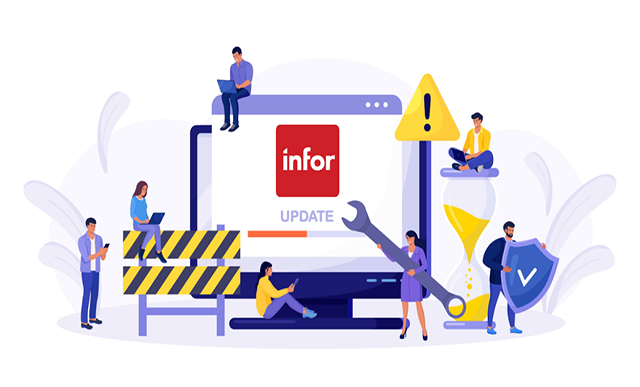It’s such a thrill getting out and about and talking to people, isn’t it? Bouncing around the bustle of the M3 User Association (M3UA) conference in Manchester last May was certainly as enlightening as it was good for my extroverted social battery, and it sprung fresh questions to mind when it came to our industry. Of particular worth, was the keynote given by Infor – it sparked a number of thoughts, and gathering those now, I reckon they are worthy enough to share.
The future of what is on offer from Infor’s new Cloudsuite sounds like many organizations can stand to benefit. However, there are some bases that organizations need to cover when it comes to Infor testing, if they want to ensure the success of their Infor platform – and business.
What did Infor say?
Infor really zoned in on the benefits of Cloudsuite – and cloud computing in general – for driving innovation and being the centerpiece of digital transformation projects.
And, of course, they’re absolutely right. Cloud apps and platforms have become common in businesses around the world. They’re great because of their flexibility, their simplicity from a business management perspective, their cost-effectiveness and because they often give you access to great tools and functionality far more easily than if you were building an on-premise IT solution. It was plain from the keynote that Infor is really hoping users will start upgrading to Cloudsuite and thus achieve significant ROI on their ERP investment.
However…
There’s always a catch
One of the things that makes cloud platforms great is that they are evergreen. A regular schedule of updates ensures that your users get the best features and functionality and that you can be confident your applications are secure. And though every new update released will be stable and functional, they could have unforeseen effects on your business processes.
If those effects are significant enough, they could disrupt your processes and bring your business grinding to a halt. Don’t believe it could never happen. Everyone from airlines to health services to banks has fallen victim to IT issues that cost them millions in lost business.
And it’s not just the ERP vendor updates that could pose a challenge. Your business likely uses a lot of other applications alongside the new software; how will an update affect how it works with your third-party applications? How might the updates to those applications affect how they work with your new ERP systems? Often, it’ll be impossible to know until the update has been released.
So, before you press the big green button and kick off your migration project, you need to ask yourself the question: will you have the capacity to properly test every update that Infor releases once you’re in Cloudsuite?
Chances are, the answer to that question (right now) is no.
Are your testing capabilities as robust as you thought?
You may observe how your organization currently accomplishes Infor testing and see no problems. Great! But the problem isn’t what you need to test now – it’s how the testing workload will change as you upgrade from Infor M3 (or any on-premise Infor platform) to Cloudsuite.
The migration itself will create a massive amount of work for your testing team. They’ll need to document every process that will need testing after the migration and, once the migration has happened, all those processes will need to be validated through user acceptance testing (UAT) – which many businesses report is a slow, manual and error-prone process.
Once the migration is finished (and all the teething problems ironed out), the testing team will need to adapt to the increased frequency of updates that require testing. If there’s one thing we’ve learned over 25 years of helping organizations improve how they test, it’s that most businesses’ testing processes will buckle under the pressure. It’s like trying to compete in the Tour de France using a bike you bought from Amazon; it just wasn’t built for the work and can’t keep up.
UAT is a particular area where we know organizations struggle because most of them try to manage it using spreadsheets and emails. As the volume of tests, feedback and queries from users (and test managers who don’t understand the feedback users have given) grows, more and more things get missed and the less confidence you have that your software is bug-free.
What can you do?
If your organization can adopt a more robust and mature approach to Infor testing, then you can unlock the benefits of Cloudsuite without having to worry about business-breaking bugs tripping you up in the future. Based on our experience supporting organizations upgrading their ERP from on-premise to the cloud, we have a few tips.
Managing all your testing centrally is integral. Do your best to reduce reliance on emails and spreadsheets or agreements made at someone’s desk half an hour ago. It goes without saying that user feedback is also a powerful testing tool. The simpler and easier you make it for a user to provide feedback, the easier it will be for devs to act.
Many of the delays that occur during testing (especially UAT) come from unclear feedback. The reality is a business needs more time to decipher the true meaning of the feedback or the feedback can just be ignored altogether. This obviously, raises the risk of more issues slipping into production.
The automation tools are available, take advantage of them. Automation makes it easier to quickly and confidently test updates. And above all else, make sure you document your processes so you can build a library of tests that make sure you’ve certified every process to succeed in the new environment.
Your cloud-computing journey awaits
It’s easy to understand why Infor is encouraging customers to embrace Cloudsuite. It’s a powerful platform and the benefits of the cloud are all there for the taking.
Hopefully, you now know how to make that journey the best one possible. Remember to, at the very least, evaluate your testing processes and entertain the possibility of overhauling them to keep pace with the volume of updates Infor is likely to release.




